Gratitude Report 2023
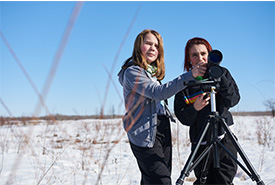
Kids with telescope. Tall Grass Prairie (Photo by D. Lipnowski)
Thank you for being a part of our nature-loving community!
There are no words to fully express our gratitude to you. Thanks to partners like you, we are making a difference in the conservation of our natural landscapes and the wildlife they sustain as well as in communities where we work and live.
As you know, the world is facing the twin crises of biodiversity loss and climate change, and these threats demand urgent solutions. But together, with nature, we are building a thriving world.
We hope that you find this Gratitude Report enjoyable and informative as you learn more about how your support is making a real difference in building a lasting impact for nature.
With gratitude,
The staff of the Nature Conservancy of Canada in Manitoba
Prairie grasslands: The unsung hero
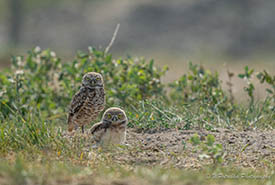
Pair of burrowing owls near a burrow at Jackson Prairie, MB (Photo by Walter Potrebka)
Canada’s Prairie grasslands are our unsung heroes. Grasslands absorb and store billions of tonnes of carbon, provide protection from flooding and drought, and help purify our water.
Prairie grasslands are essential for humans, but also for the numerous species that rely on the ecosystem to survive, like swift fox, ferruginous hawk, and burrowing owl.
Spanning Manitoba, Saskatchewan, and Alberta, they’re one of the world’s most endangered ecosystems. Over 80 per cent of Canada’s Prairie grasslands have been lost already, and what remains is at risk of disappearing forever. In the time it takes to watch your favourite television show, the equivalent of 12 CFL-sized football fields will be lost to conversion and human activity. By the end of the day, another 260 football fields will be gone. Every year, 60,000 hectares, or 100,000 football fields, disappear.
Prairie Grasslands Action Plan
We’re rallying people and communities to conserve and care for this vital, endangered ecosystem. Our Prairie Grasslands Action Plan will conserve more than 500,000 hectares by 2030 – an area six times the size of Calgary, equivalent to what we will lose if we don’t act now to protect the grasslands that remain.
It’s a once-in-a-lifetime opportunity. With partnerships at the heart of this plan, NCC is working with local communities, livestock producers and grazing groups, and in collaboration with Indigenous Nations, industry and government, to deliver solutions that ensure the grasslands remain a foundation for thriving communities.
The Prairie Grasslands Action Plan will provide effective solutions to counter rapid biodiversity loss and climate change. Your support will secure and restore rare habitats, protect species at risk, and improve the quality of our air and water.
To learn more, visit prairiegrasslands.ca.
21 Farms
We are excited to share that NCC secured its largest conservation agreement in Manitoba!
At close to 455 hectares, this project boasts native mixed-grass prairie and bur oak savannah, along with sandhill prairie and sandhill forest. The project also supports elk, coyote, American badger, Sprague’s pipit and a large sharped-tail grouse lek. The 21 Farms project is currently grazed, and the intent is that it will remain as pastureland, consistent with NCC’s vision for healthy and resilient prairie that is part of a sustainable and vibrant livestock grazing industry.
This project was made possible, in part, thanks to our wonderful donors Eric and Carol Moore, who gifted a significant portion of the agreement value.
Learn more about how Carol and Eric got in touch and collaborated with NCC.
Wabano Aki, Tomorrows Land
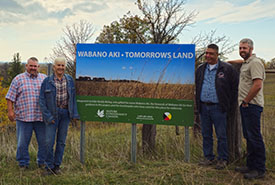
L-R: Kevin Teneycke, Gordon Beddome, Ken Norquay and Josh Dillabough at Wabano Aki (Photo by Fayaz Hasan / NCC Staff)
Over the last five years, NCC has been working on a partnership near Brandon which serves as testament of the whole-of-society approach necessary to address the dual crises of biodiversity loss and climate change.
The area is important culturally, agriculturally and for biodiversity conservation. Near to an area known as Waggle Springs, the land has been named Wabano Aki following a naming ceremony with Elder Roddy McKay, Anishinaabe cultural support worker Ken Norquay, Gordon Beddome and NCC, collectively known as the Stewards of Wabano Aki. During the process, all parties shared their experiences, stories and understandings of how to live in harmony with the land. In Anishinaabe, Wabano Aki translates to Tomorrows Land.
Collectively, the Stewards of Wabano Aki all are working to conserve the land and species that grow and live there, hand in hand with the human communities that depend on it, sustainably into the future. The stewards will continue to embrace agriculture, conservation and ceremonial purposes on the land. A plan for managing the property includes collaborative approaches to access and different uses of the lands and traditional Indigenous knowledge and practices as well as best conservation science. Portions of the property are also being leased by one of the previous landowners and other renters for grazing cattle and goats.
Next generation conservation leaders
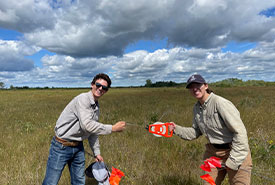
NGCLs Kale Cohen and Megan Miller (Photo by Meg Lovett / NCC staff)
This year, the investment in hiring and supporting interns and seasonal staff through the Next Generation of Conservation Leaders (NGCL) program really paid off.
With a record number of applicants, six well-qualified NGCL’s started working as a part of the team in May. Since spring, we have enjoyed working alongside Kale Cohen, Jacalyn Grey, Lauren James, Evan Mah, Megan Miller, and Karine Whitcher and incorporating them into the NCC team and the greater Manitoba conservation community. They have made meaningful contributions to conservation while gaining career-benefiting experience across core functional areas, including science and planning, stewardship, community relations and administration. Some highlights include joining the prescribed fire crew and winning an award for the best float in the Vita Canada Day parade.
We are grateful that donors have continued to support opportunities for early-career conservation professionals in Manitoba. Donor support, like that from Jim and Leney Richardson and Wawanesa, provide the financial flexibility necessary to provide the full range of experiences.
Southwest Manitoba Priority Place Community Workshops
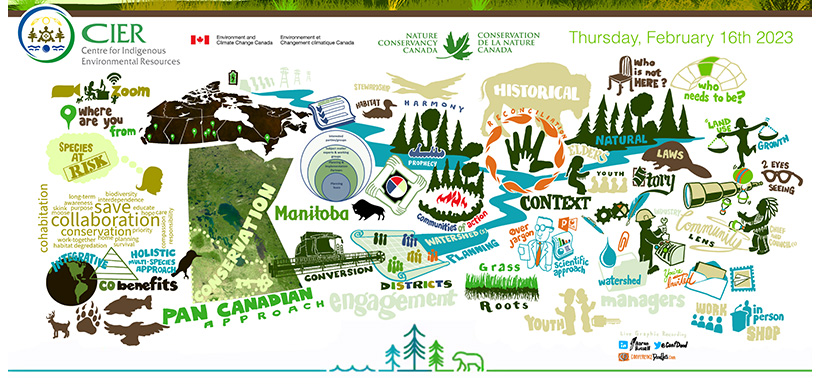
Graphic recording of the first SWMPP workshop by Aaron Russell, Conference Doodles
NCC and Environment and Climate Change Canada have been co-leading the Southwest Manitoba Priority Place Initiative. Together, we are creating a community-driven initiative that focuses on partnership in order to conserve, protect and recover endangered and threatened species and the land and waters they rely on.
This year, engagement workshops were held in nine communities, engaging nearly 200 participants representing a cross-section of residents, all levels of government, conservation, and agriculture.
Workshops were focused on engaging Indigenous and rural communities with the priority of building relationships and learning the priorities, challenges and interests of communities, and how these focus areas connect to nature, conservation and species at risk.
Next steps include compiling reports and lessons-learned from the workshops and working with a market research company to further understand people's perceptions of conservation and species at risk on the landscape.
Together, we are making a difference!
This project was undertaken with the financial support of Environment and Climate Change Canada.
Fort Ellice Interpretive Site
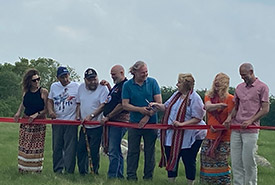
Fort Ellice Interpretive Site inauguration ribbon cutting. (Photo by Jennifer McKillop / NCC staff)
On May 26, 2023, nearly 200 people attended the opening ceremony for the Fort Ellice Interpretive Site.
The site has been in the works for many years and finally came to fruition thanks to the hard work from many partners including NCC, CDC P’tite Forche, Rural Municipality of Ellice-Archie, Manitoba Métis Federation and several First Nation communities, including the Waywayseecappo First Nation.
The Fort Ellice property is not only important as an ecological gem, but it’s also an opportunity to bring together nature, history, culture and local economy.
NCC is proud to have worked with those involved in the creation of a space that continues to build on the connections to the land. As a gathering place for many generations, it’s inspiring to know that future generations have the opportunity to connect with this place and their personal history. It is our hope that this site will strengthen visitors’ sense of self and community through a love of nature and their desire to protect the natural world around them.
Thank you for your support!
Thank you for playing a vital role in the conservation of our natural landscapes and the species they sustain. With you, we are building a thriving world.




